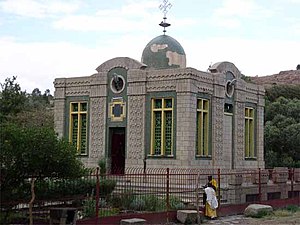Church of Our Lady Mary of Zion: Difference between revisions
Wikify Mary |
No edit summary |
||
| Line 6: | Line 6: | ||
Since its founding during the episcopacy of [[Frumentius]] (known in Ethiopia as ''Abune Selama Kesatay Birhan'' or "Our Father of Peace and Revealer of Light") the Church of Mary of Zion has been destroyed and rebuilt at least twice. Its first destruction occurred at the hands of Queen [[Gudit]] during the 11th century. Its second destruction occurred several centuries later at the hands of the great Muslim warrior of [[Harar]], [[Ahmad ibn Ibrihim al-Ghazi]], after which it was rebuilt by the Emperor [[Fasilidos of Ethiopia|Fasilidos]] during the [[1600s]]. |
Since its founding during the episcopacy of [[Frumentius]] (known in Ethiopia as ''Abune Selama Kesatay Birhan'' or "Our Father of Peace and Revealer of Light") the Church of Mary of Zion has been destroyed and rebuilt at least twice. Its first destruction occurred at the hands of Queen [[Gudit]] during the 11th century. Its second destruction occurred several centuries later at the hands of the great Muslim warrior of [[Harar]], [[Ahmad ibn Ibrihim al-Ghazi]], after which it was rebuilt by the Emperor [[Fasilidos of Ethiopia|Fasilidos]] during the [[1600s]]. |
||
In the [[1900s]] the Emperor [[Haile Selassie of Ethiopia|Haile Selassie]] built a new, much grander cathedral next to the original Church of Our Lady Mary of Zion that was open to both men and women (the old church remains accessible only to men, as [[Mary, mother of |
In the [[1900s]] the Emperor [[Haile Selassie of Ethiopia|Haile Selassie]] built a new, much grander cathedral next to the original Church of Our Lady Mary of Zion that was open to both men and women (the old church remains accessible only to men, as [[Mary, the mother of Jesus|Mary]], symbolized by the [[Ark of the Covenant]] resting in its chapel, is the only woman allowed within its compound). |
||
Reportedly, the Ark has been moved to the recently built Chapel of the Tablet adjacent to the old church because a divine 'heat' from the Tablets had cracked the stones of its previous sanctum. It remains a significant center of [[pilgrimage]] for Ethiopian Orthodox Christians, especially during the main [[Festival of Maryam Zion]] on [[November 30|30 November]] (21 Hidar on the Ethiopian calendar). |
Reportedly, the Ark has been moved to the recently built Chapel of the Tablet adjacent to the old church because a divine 'heat' from the Tablets had cracked the stones of its previous sanctum. It remains a significant center of [[pilgrimage]] for Ethiopian Orthodox Christians, especially during the main [[Festival of Maryam Zion]] on [[November 30|30 November]] (21 Hidar on the Ethiopian calendar). |
||
Revision as of 19:58, 12 December 2005

The Church of Our Lady Mary of Zion (“Igzi’itne Maryam S’iyon Yeityop'iya Ortodoks Baytekristiyan” in the languages of Ethiopia) of the Ethiopian Orthodox Church is the most important and one of the oldest churches of Ethiopia. The original church is believed to have been built during the reign of Ezana, the first Orthodox Christian emperor of Ethiopia, during the fourth century AD.
The church, in the town of Axum in Tigray Province, claims to contain the original Ark of the Covenant. According to tradition, Menelik I brought it to Ethiopia after visiting his father King Solomon. Only the head priest of the Church may view the Ark, in accordance with the Bible accounts of the dangers of doing so for non-Levites. This lack of accessibility, and questions about the account as a whole, has led foreign scholars to express doubt about the veracity of the claim.
Since its founding during the episcopacy of Frumentius (known in Ethiopia as Abune Selama Kesatay Birhan or "Our Father of Peace and Revealer of Light") the Church of Mary of Zion has been destroyed and rebuilt at least twice. Its first destruction occurred at the hands of Queen Gudit during the 11th century. Its second destruction occurred several centuries later at the hands of the great Muslim warrior of Harar, Ahmad ibn Ibrihim al-Ghazi, after which it was rebuilt by the Emperor Fasilidos during the 1600s.
In the 1900s the Emperor Haile Selassie built a new, much grander cathedral next to the original Church of Our Lady Mary of Zion that was open to both men and women (the old church remains accessible only to men, as Mary, symbolized by the Ark of the Covenant resting in its chapel, is the only woman allowed within its compound).
Reportedly, the Ark has been moved to the recently built Chapel of the Tablet adjacent to the old church because a divine 'heat' from the Tablets had cracked the stones of its previous sanctum. It remains a significant center of pilgrimage for Ethiopian Orthodox Christians, especially during the main Festival of Maryam Zion on 30 November (21 Hidar on the Ethiopian calendar).
